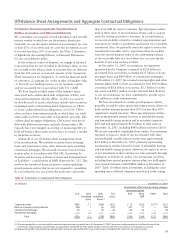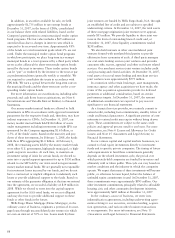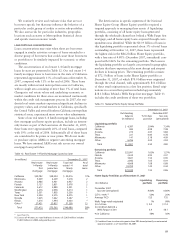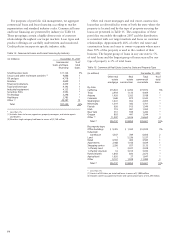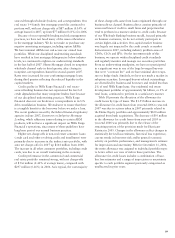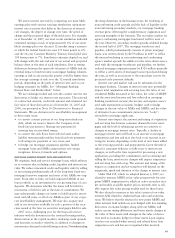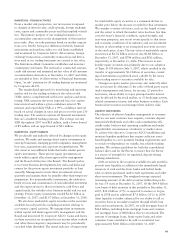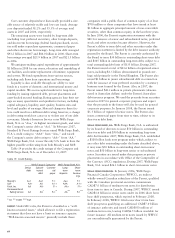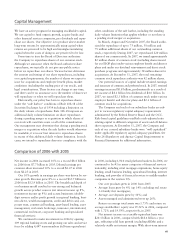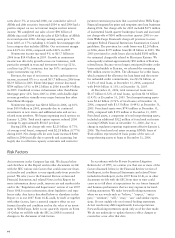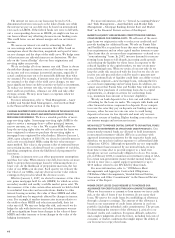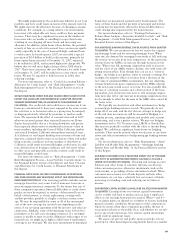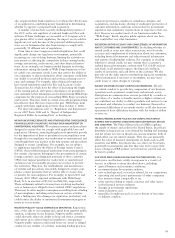Wells Fargo 2007 Annual Report Download - page 64
Download and view the complete annual report
Please find page 64 of the 2007 Wells Fargo annual report below. You can navigate through the pages in the report by either clicking on the pages listed below, or by using the keyword search tool below to find specific information within the annual report.61
We assess interest rate risk by comparing our most likely
earnings plan with various earnings simulations using many
interest rate scenarios that differ in the direction of interest
rate changes, the degree of change over time, the speed of
change and the projected shape of the yield curve. For example,
as of December 31, 2007, our most recent simulation indicated
estimated earnings at risk of approximately 4% of our most
likely earnings plan over the next 12 months using a scenario
in which the federal funds rate rises 175 basis points to 6%
and the 10-year Constant Maturity Treasury bond yield rises
300 basis points to 7%. Simulation estimates depend on, and
will change with, the size and mix of our actual and projected
balance sheet at the time of each simulation. Due to timing
differences between the quarterly valuation of MSRs and the
eventual impact of interest rates on mortgage banking volumes,
earnings at risk in any particular quarter could be higher than
the average earnings at risk over the 12-month simulation
period, depending on the path of interest rates and on our
hedging strategies for MSRs. See “Mortgage Banking
Interest Rate and Market Risk” below.
We use exchange-traded and over-the-counter interest rate
derivatives to hedge our interest rate exposures. The notional
or contractual amount, credit risk amount and estimated net
fair value of these derivatives as of December 31, 2007 and
2006, are presented in Note 16 (Derivatives) to Financial
Statements. We use derivatives for asset/liability management
in three main ways:
• to convert a major portion of our long-term fixed-rate
debt, which we issue to finance the Company, from
fixed-rate payments to floating-rate payments by
entering into receive-fixed swaps;
• to convert the cash flows from selected asset and/or
liability instruments/portfolios from fixed-rate payments
to floating-rate payments or vice versa; and
• to hedge our mortgage origination pipeline, funded
mortgage loans and MSRs using interest rate swaps,
swaptions, futures, forwards and options.
MORTGAGE BANKING INTEREST RATE AND MARKET RISK
We originate, fund and service mortgage loans, which subjects
us to various risks, including credit, liquidity and interest rate
risks. We reduce unwanted credit and liquidity risks by selling
or securitizing predominantly all of the long-term fixed-rate
mortgage loans we originate and most of the ARMs we orig-
inate. From time to time, we hold originated ARMs in our
loan portfolio as an investment for our growing base of core
deposits. We determine whether the loans will be held for
investment or held for sale at the time of commitment. We
may subsequently change our intent to hold loans for invest-
ment and sell some or all of our ARMs as part of our corpo-
rate asset/liability management. We may also acquire and
add to our securities available for sale a portion of the secu-
rities issued at the time we securitize mortgages held for sale.
2007 was a challenging year for the financial services
industry with the downturn in the national housing market,
deterioration in the capital markets, widening credit spreads
and increases in market volatility, in addition to changes in
interest rates discussed in the following sections. Notwithstanding
the sharp downturn in the housing sector, the widening of
nonconforming credit spreads and the lack of liquidity in the
nonconforming secondary markets, our mortgage banking
revenue grew, reflecting the complementary origination and
servicing strengths of the business. The secondary market for
agency-conforming mortgages functioned well for most of
the year. However, secondary market spreads widened during
the second half of 2007. The mortgage warehouse and
pipeline, which predominantly consists of prime mortgage
loans, was written down by $479 million in 2007 to reflect
the unusual widening in nonconforming and conforming
agency market spreads. In addition to the write-down associ-
ated with the mortgage warehouse and pipeline, we further
reduced mortgage origination gains by $324 million primarily
to reflect a write-down of mortgage loans repurchased during
the year, as well as an increase to the repurchase reserve for
projected early payment defaults.
Interest rate and market risk can be substantial in the
mortgage business. Changes in interest rates may potentially
impact total origination and servicing fees, the value of our
residential MSRs measured at fair value, the value of MHFS
and the associated income and loss reflected in mortgage
banking noninterest income, the income and expense associ-
ated with instruments (economic hedges) used to hedge
changes in the fair value of MSRs and MHFS, and the value
of derivative loan commitments (interest rate “locks”)
extended to mortgage applicants.
Interest rates impact the amount and timing of origination
and servicing fees because consumer demand for new mort-
gages and the level of refinancing activity are sensitive to
changes in mortgage interest rates. Typically, a decline in
mortgage interest rates will lead to an increase in mortgage
originations and fees and may also lead to an increase in ser-
vicing fee income, depending on the level of new loans added
to the servicing portfolio and prepayments. Given the time it
takes for consumer behavior to fully react to interest rate
changes, as well as the time required for processing a new
application, providing the commitment, and securitizing and
selling the loan, interest rate changes will impact origination
and servicing fees with a lag. The amount and timing of the
impact on origination and servicing fees will depend on the
magnitude, speed and duration of the change in interest rates.
Under FAS 159, which we adopted January 1, 2007, we
elected to measure MHFS at fair value prospectively for new
prime MHFS originations for which an active secondary mar-
ket and readily available market prices currently exist to reli-
ably support fair value pricing models used for these loans.
We also elected to measure at fair value certain of our other
interests held related to residential loan sales and securitiza-
tions. We believe that the election for new prime MHFS and
other interests held (which are now hedged with free-standing
derivatives (economic hedges) along with our MSRs) will
reduce certain timing differences and better match changes in
the value of these assets with changes in the value of deriva-
tives used as economic hedges for these assets. Loan origina-
tion fees are recorded when earned, and related direct loan
origination costs and fees are recognized when incurred.


